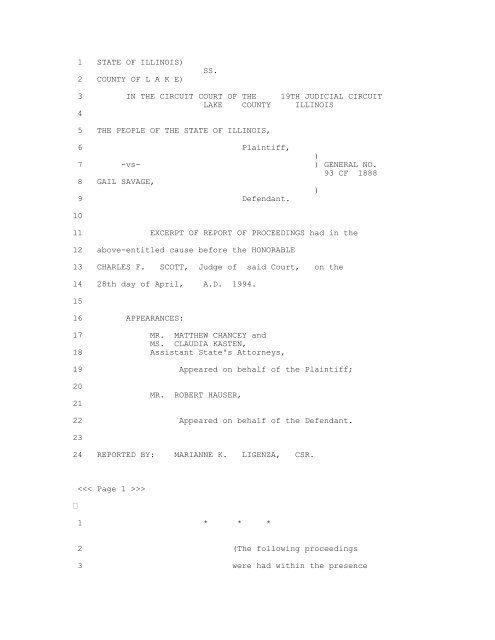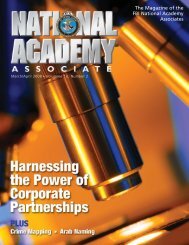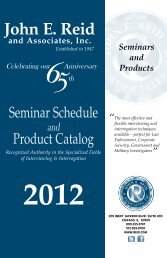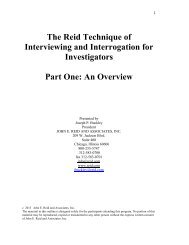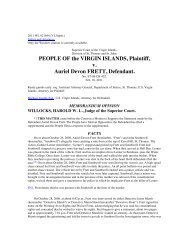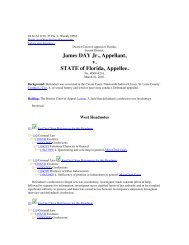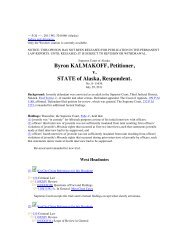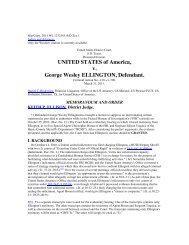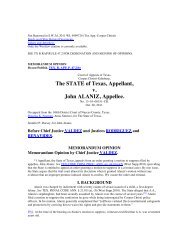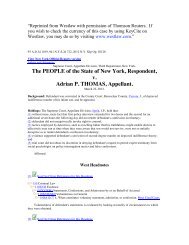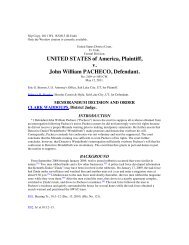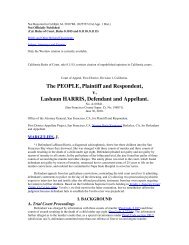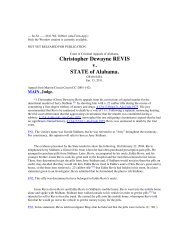View Document - The Reid Technique of interviewing and ...
View Document - The Reid Technique of interviewing and ...
View Document - The Reid Technique of interviewing and ...
Create successful ePaper yourself
Turn your PDF publications into a flip-book with our unique Google optimized e-Paper software.
1<br />
STATE OF ILLINOIS)<br />
2 COUNTY OF L A K E)<br />
SS.<br />
3 IN THE CIRCUIT COURT OF THE 19TH JUDICIAL CIRCUIT<br />
LAKE COUNTY ILLINOIS<br />
4<br />
5 THE PEOPLE OF THE STATE OF ILLINOIS,<br />
6 Plaintiff,<br />
)<br />
7 -vs- ) GENERAL NO.<br />
93 CF 1888<br />
8 GAIL SAVAGE,<br />
)<br />
9 Defendant.<br />
10<br />
11 EXCERPT OF REPORT OF PROCEEDINGS had in the<br />
12 above-entitled cause before the HONORABLE<br />
13 CHARLES F. SCOTT, Judge <strong>of</strong> said Court, on the<br />
14 28th day <strong>of</strong> April, A.D. 1994.<br />
15<br />
16 APPEARANCES:<br />
17 MR. MATTHEW CHANCEY <strong>and</strong><br />
MS. CLAUDIA KASTEN,<br />
18 Assistant State's Attorneys,<br />
19 Appeared on behalf <strong>of</strong> the Plaintiff;<br />
20<br />
21<br />
MR. ROBERT HAUSER,<br />
22 Appeared on behalf <strong>of</strong> the Defendant.<br />
23<br />
24 REPORTED BY: MARIANNE K. LIGENZA, CSR.<br />
<br />
><br />
1 * * *<br />
2 (<strong>The</strong> following proceedings<br />
3 were had within the presence
4 <strong>and</strong> hearing <strong>of</strong> the jury:)<br />
5 RICHARD OFSHE,<br />
6 having been previously sworn, was examined <strong>and</strong><br />
7 testified as follows:<br />
8 DIRECT EXAMINATION<br />
9 BY MR. HAUSER:<br />
10 Q Doctor, would you tell us your name, please?<br />
11 A Richard J. Ofshe.<br />
12 Q Would you spell the last name for the court<br />
13 reporter?<br />
14 A O-f-s-h-e.<br />
15 Q And I call you doctor. Could you relate<br />
16 what type <strong>of</strong> doctor you are?<br />
17 A My doctorate is in sociology, <strong>and</strong> my area <strong>of</strong><br />
18 expertise within that field is in social psychology.<br />
19 MR. CHANCEY: Objection.<br />
20 THE COURT: Step up.<br />
21 (Proceedings were had outside<br />
22 the hearing <strong>of</strong> the jury,<br />
23 after which the following<br />
24 proceedings were had within<br />
2<br />
><br />
<br />
1 the hearing <strong>of</strong> the jury:)<br />
2 BY MR. HAUSER:<br />
3 Q I am sorry, your specialty is within --<br />
4 MR. CHANCEY: Objection, asked <strong>and</strong> answered.<br />
5 MR. HAUSER: Excuse me. You jumped all over<br />
6 it.
7 THE COURT: Sustained.<br />
8 MR. HAUSER: May I approach?<br />
9 (Proceedings were had outside<br />
10 the hearing <strong>of</strong> the jury,<br />
11 after which the following<br />
12 proceedings were had within<br />
13 the hearing <strong>of</strong> the jury:)<br />
14 BY MR. HAUSER:<br />
15 Q And what is social psychology, Doctor?<br />
16 A Social psychology is a subdiscipline or a<br />
17 specialty within both sociology <strong>and</strong> psychology.<br />
18 THE COURT: Excuse me. Step up.<br />
19 (Proceedings were had outside<br />
20 the hearing <strong>of</strong> the jury,<br />
21 after which the following<br />
22 proceedings were had within<br />
23 the hearing <strong>of</strong> the jury:)<br />
24 BY MR. HAUSER:<br />
3<br />
><br />
<br />
1 Q Doctor, what degrees or education do you<br />
2 have in social psychology?<br />
3 A Most <strong>of</strong> my training in graduate school was<br />
4 all within the area <strong>of</strong> social psychology, <strong>and</strong> since<br />
5 completing my Ph.D. in 1967, all <strong>of</strong> my work for the<br />
6 next 27 years has been in the area <strong>of</strong> social<br />
7 psychology, all the research that I have done since<br />
8 then, so it starts in my undergraduate career,
9 actually, in the Psychology Department, <strong>and</strong><br />
10 continues through graduate work <strong>and</strong> continues in the<br />
11 next 27 years in research <strong>and</strong> teaching.<br />
12 I am a member <strong>of</strong> both the American<br />
13 Psychological Association <strong>and</strong> the American<br />
14 Sociological Association, <strong>and</strong> within each<br />
15 association, there are sub areas in social<br />
16 psychology. I am a member <strong>of</strong> each sub group within<br />
17 these two pr<strong>of</strong>essional associations.<br />
18 Q And social psychology -- I am sorry, social<br />
19 psychology is recognized in the psychological<br />
20 association?<br />
21 A Yes, it's a subspecialty both within<br />
22 psychology <strong>and</strong> sociology.<br />
23 Q And what is social psychology?<br />
24 A It's an area that studies particularly<br />
4<br />
><br />
<br />
1 issues <strong>of</strong> influence, group pressure, for example,<br />
2 individual decision-making <strong>and</strong> response to immediate<br />
3 social pressures, a number <strong>of</strong> other topics, but<br />
4 those are the ones I particularly specialize in.<br />
5 Q What do you mean by influence?<br />
6 MR. CHANCEY: Objection.<br />
7 (Proceedings were had outside<br />
8 the hearing <strong>of</strong> the jury,<br />
9 after which the following<br />
10 proceedings were had within<br />
11 the hearing <strong>of</strong> the jury:)
12 BY MR. HAUSER:<br />
13 Q Doctor, in the area <strong>of</strong> influence, <strong>and</strong> I am<br />
14 sorry, that was influence in what?<br />
15 A In interpersonal setting, group setting, in<br />
16 any setting in which there is an attempt to mollify<br />
17 the attitudes, beliefs or behavior <strong>of</strong> an individual<br />
18 through the actions <strong>of</strong> another.<br />
19 Q Now, what, in fact, studies have you done in<br />
20 your 20 some years as to the area <strong>of</strong> influence,<br />
21 influencing individuals?<br />
22 A Beginning in 19 -- published in 1968, I<br />
23 started, I published research on the impact <strong>of</strong><br />
24 interaction <strong>and</strong> the manner in which people<br />
5<br />
><br />
<br />
1 effectively communicate with one another.<br />
2 Subsequent to that, I published in 1969<br />
3 initially an article <strong>and</strong> then a book on individual<br />
4 decision-making in groups. It had to do with the<br />
5 impact, the behavior <strong>of</strong> others on particular<br />
6 decisions that an individual would make. This was<br />
7 what's called microeconomic sort <strong>of</strong> work, math. It<br />
8 was laboratory-based research.<br />
9 I continued working in that area<br />
10 through the late '60s <strong>and</strong> into the 1970s, <strong>and</strong> in<br />
11 1970, published an article on the developments <strong>of</strong><br />
12 group structure <strong>and</strong> how it is that dominance orders<br />
13 form in small interactive groups. I published on
14 the effectiveness <strong>of</strong> pacifist strategies as an<br />
15 influence technique.<br />
16 I published on the subject <strong>of</strong> how it is<br />
17 that people maintain relations with others where<br />
18 there are competing expectations brought to bear on<br />
19 them; how those expectations influence their<br />
20 behavior.<br />
21 <strong>The</strong>n, starting in the -- other<br />
22 publications in the area <strong>of</strong> individual<br />
23 decision-making <strong>and</strong> group process, starting in the<br />
24 early 1970s, I began to study more complex<br />
6<br />
><br />
<br />
1 environments, not laboratory settings, but rather,<br />
2 real world environments in which extremes <strong>of</strong><br />
3 influence were brought to bear on individuals. My<br />
4 first work in that area had to do with an<br />
5 organization called Synanon, which started out as a<br />
6 drug rehabilitation organization <strong>and</strong> used intense<br />
7 tactics <strong>of</strong> influence <strong>and</strong> manipulation on<br />
8 individuals.<br />
9 Synanon eventually developed into a<br />
10 violent cult group, <strong>and</strong> I studied the tactics that<br />
11 were used to manipulate individuals who would enter<br />
12 the group, non-violents <strong>and</strong> individuals whose<br />
13 biographies would not indicate that they would be<br />
14 likely to take part in violence, <strong>and</strong> the manner in<br />
15 which they were manipulated <strong>and</strong> gotten to<br />
16 participate in the violence that was characterizing
17 Synanon at the time.<br />
18 Q Did you write any articles on that?<br />
19 A Yes, I wrote articles in scientific journals<br />
20 as well as participated in a journalism series with<br />
21 two individuals who owned a small weekly newspaper<br />
22 in West Baron County, California, <strong>and</strong> that series<br />
23 that we published in 1970 --<br />
24 MR. CHANCEY: Objection.<br />
7<br />
><br />
<br />
1 THE COURT: Step up.<br />
2 (Proceedings were had outside<br />
3 the hearing <strong>of</strong> the jury,<br />
4 after which the following<br />
5 proceedings were had within<br />
6 the hearing <strong>of</strong> the jury:)<br />
7 BY MR. HAUSER:<br />
8 Q Doctor, what other work did you do in terms<br />
9 <strong>of</strong> the area <strong>of</strong> influencing people?<br />
10 A <strong>The</strong>n I continued to publish some additional<br />
11 laboratory research as well as other things.<br />
12 Q What type <strong>of</strong> laboratory research in terms <strong>of</strong><br />
13 influencing people?<br />
14 A This had to do with testing particular<br />
15 theories <strong>of</strong> how it is that influence is transmitted<br />
16 from authority figures to individuals <strong>and</strong> how<br />
17 authoritative influence affects their judgments <strong>and</strong><br />
18 decision-making.
19 Q When was that work done?<br />
20 A That was published in the early 1980s.<br />
21 <strong>The</strong>re are actually three or four publications along<br />
22 those lines in that period.<br />
23 Q And was that published in a scientific<br />
24 journal?<br />
8<br />
><br />
<br />
1 A <strong>The</strong>se would have been published in a journal<br />
2 called Social Psychology Quarterly, <strong>and</strong> then an<br />
3 article, a chapter in a book, on a theory <strong>of</strong><br />
4 individual decision-making, <strong>and</strong> then subsequent to<br />
5 that --<br />
6 Q Wait a second. As far as this chapter in<br />
7 the book as far as individual decision-making, did<br />
8 it deal with influence upon that individual<br />
9 decision-making?<br />
10 A Yes, it did.<br />
11 Q Do you remember the title <strong>of</strong> that book?<br />
12 A <strong>The</strong> book was called Rationality <strong>and</strong><br />
13 Collective Belief. It was a scholarly book, <strong>and</strong> I<br />
14 contributed to a chapter called <strong>The</strong> Two Process<br />
15 <strong>The</strong>ories <strong>of</strong> Social Behavior.<br />
16 Q And you dealt -- <strong>and</strong> where did you get the<br />
17 material for which you included or wrote this<br />
18 chapter?<br />
19 A That particular material came from<br />
20 laboratory studies, individual decision-making with<br />
21 group influence.
22 Q What do you mean by individual<br />
23 decision-making with group influence?<br />
24 MR. CHANCEY: Objection.<br />
9<br />
><br />
<br />
1 THE COURT: Overruled.<br />
2 A It would have to do either with people<br />
3 interacting in groups <strong>and</strong> the effective group<br />
4 structure <strong>and</strong> pressures brought to bear by a group<br />
5 <strong>of</strong> individuals, or it would have to do with<br />
6 individual decision-making or the decision-making <strong>of</strong><br />
7 individuals, not necessarily in a group setting, but<br />
8 in some kind <strong>of</strong> social setting, where, for example,<br />
9 an authority figure was bringing to bear influence<br />
10 on an individual.<br />
11 Q And, in fact, these were laboratory studies<br />
12 where, in fact, individuals were studied in terms <strong>of</strong><br />
13 their decision-making when, in fact, pressure was<br />
14 placed on them by others?<br />
15 MR. CHANCEY: Objection.<br />
16 (Proceedings were had outside<br />
17 the hearing <strong>of</strong> the jury,<br />
18 after which the following<br />
19 proceedings were had outside<br />
20 the presence <strong>and</strong> hearing <strong>of</strong><br />
21 the jury:)<br />
22 BY MR. HAUSER:<br />
23 Q Do you remember the last question?
24 THE COURT: Read it back.<br />
10<br />
><br />
<br />
1 (Question read back by court<br />
2 reporter.)<br />
3 A That's correct.<br />
4 BY MR. HAUSER:<br />
5 Q And how, in fact, was this laboratory test<br />
6 set up?<br />
7 A That particular paper dealt with analyzing a<br />
8 great number <strong>of</strong> experiments, most <strong>of</strong> them by other<br />
9 people reanalyzing data <strong>and</strong> analyzing trends in the<br />
10 literature <strong>and</strong> assuming it under a single analysis<br />
11 <strong>of</strong> what was going on in these various settings, so<br />
12 it covered a broad range <strong>of</strong> published studies <strong>and</strong><br />
13 data from published studies.<br />
14 Q And where did you get this data from other<br />
15 studies?<br />
16 A Published in the literature.<br />
17 Q Literature, referring to --<br />
18 A <strong>The</strong> scientific literature.<br />
19 Q Within psychology?<br />
20 A Psychology <strong>and</strong> sociology.<br />
21 Q Okay. What other studies have you done as<br />
22 far as influence, influence upon individuals?<br />
23 A Well, then, the next couple <strong>of</strong> publications<br />
24 have to do with group influence in highly controlled<br />
11
<br />
1 groups <strong>and</strong> attitude change <strong>and</strong> behavior control, so<br />
2 these have to do with extreme techniques <strong>of</strong><br />
3 influence brought to bear on indiv~iduals to change<br />
4 their perspectives <strong>and</strong> ready them for management by<br />
5 what are generally called consult groups.<br />
6 <strong>The</strong>n there are a series <strong>of</strong> publications<br />
7 there --<br />
8 Q When was that, approximately, Doctor?<br />
9 A Those would have been in the mid to late<br />
10 1980s.<br />
11 Q Okay.<br />
12 A And then in 1989, I published a paper on<br />
13 coerced confessions, which was based on a series <strong>of</strong><br />
14 case studies that I have done <strong>of</strong> police<br />
15 interrogations.<br />
16 Q And when, in fact, did you become involved<br />
17 with the study <strong>of</strong> police interrogations?<br />
18 A Probably about 198 -- well, police<br />
19 interrogation as it appears in the United States,<br />
20 probably in about 1988 or so was the first time that<br />
21 I specifically studied American police interrogation<br />
22 tactics.<br />
23 Q Now, before you started studying<br />
24 specifically American police interrogation tactics,<br />
12<br />
<br />
>
1<br />
was your work in the area <strong>of</strong> social psychology, did<br />
2 it deal with this?<br />
3 A Yes. <strong>The</strong> subject <strong>of</strong> police interrogation is<br />
4 one that runs through other areas that I have been<br />
5 working in, <strong>and</strong> so it's generally recognized that<br />
6 some forms <strong>of</strong> extreme influence actually developed<br />
7 out <strong>of</strong> police interrogation tactics <strong>and</strong> were then<br />
8 utilized in a broader form.<br />
9 Q How, in fact, did your earlier work deal or<br />
10 evidence part <strong>of</strong> it the techniques that police use<br />
11 in interrogation?<br />
12 A Well, the literature that dealt with these<br />
13 subjects starts out with the analysis <strong>of</strong> police<br />
14 interrogation, because thats where these procedures<br />
15 evolved from.<br />
16 Q Can you be specific? What are you referring<br />
17 to?<br />
18 A Specifically, the study <strong>of</strong> whats called<br />
19 coercive persuasion or thought reform, which are the<br />
20 extreme techniques brought to bear on individuals<br />
21 for eliciting false confessions as practiced by the<br />
22 Soviets after the revolution in China written by --<br />
23 an article by Hinkle <strong>and</strong> Wolf on Chinese<br />
24 interrogation tactics, <strong>and</strong> then in the work <strong>of</strong><br />
13<br />
><br />
<br />
1 Robert Lefton, dealing with interrogation <strong>and</strong><br />
2 coercive persuasion or thought reform in China after<br />
3 the revolution there. This subject matter runs
4<br />
throughout all that literature because the basics <strong>of</strong><br />
5 how this kind <strong>of</strong> intense influence -- intense<br />
6 influence systems were developed start with the<br />
7 utilization <strong>of</strong> police interrogation tactics<br />
8 specifically.<br />
9 Q What police interrogation tactics have you<br />
10 referred to specifically?<br />
11 A Well, here, they have to do with the tactics<br />
12 used by the Soviet police prior to the revolution,<br />
13 which were then adopted by the Soviets after the<br />
14 revolution <strong>and</strong> became the basis out <strong>of</strong> which KGB<br />
15 interrogation tactics arose.<br />
16 Q Now, when you began to study specifically<br />
17 American police interrogation tactics or techniques,<br />
18 what, in fact, specifically, did you study?<br />
19 A Initially, I had been involved in several<br />
20 instances in which individuals were interrogated by<br />
21 private investigators <strong>and</strong> had given false<br />
22 confessions in response to the private<br />
23 interrogation, private interrogator tactics, which<br />
24 were, nevertheless, police interrogation tactics<br />
14<br />
><br />
<br />
1 except used by private individuals, private security<br />
2 people.<br />
3 Q How, in fact, did you examine or analyze<br />
4 these private investigator tactics?<br />
5 A I was contacted by attorneys who were
6<br />
representing individuals who had been subject to<br />
7 these techniques <strong>and</strong> asked to evaluate the procedure<br />
8 brought to bear on them that led to these false<br />
9 confessions.<br />
10 Q Did you render reports --<br />
11 THE COURT: Excuse me. Is this in '88 or<br />
12 '89 that you are talking about?<br />
13 THE WITNESS: <strong>The</strong>se two civil cases would<br />
14 have preceded that. This would probably be '85 or<br />
15 '86.<br />
16 THE COURT: Okay.<br />
17 BY MR. HAUSER:<br />
18 Q And did you render any opinions in those<br />
19 instances?<br />
20 A Yes. I testified in both those cases in<br />
21 court as well as was deposed.<br />
22 Q You did testify in open court in a trial?<br />
23 A Oh, yes, in both <strong>of</strong> those.<br />
24 Q And what opinions did you render in those<br />
15<br />
><br />
<br />
1 cases?<br />
2 A <strong>The</strong> opinions had to do with the way in which<br />
3 false confessions were elicited from these two<br />
4 individuals.<br />
5 Q And, in fact, you testified as to how they<br />
6 were, in fact, elicited, <strong>and</strong>, in fact, that the<br />
7 confessions were false?<br />
8 A Correct.
9 Q Now, as far as the police tactics that you<br />
10 referred to, what further studies have you done in<br />
ii<br />
terms <strong>of</strong> the American police interrogation<br />
12 techniques or tactics?<br />
13 A Okay. <strong>The</strong> publication in 1989, which is the<br />
14 first publication on this --<br />
15 THE COURT: Can you tell me the title <strong>of</strong><br />
16 that, please?<br />
17 THE WITNESS: Coerced Confessions, <strong>The</strong> Logic<br />
18 <strong>of</strong> Seemingly Irrational Action. And that was based<br />
19 on a series <strong>of</strong> case studies --<br />
20 THE COURT: <strong>The</strong> logic <strong>of</strong> what?<br />
21 THE WITNESS: Seemingly irrational action.<br />
22 THE COURT: Okay.<br />
23 THE WITNESS: That was based on the case<br />
24 studies, including the two cases I mentioned,<br />
16<br />
><br />
<br />
1 together with transcripts <strong>of</strong> interrogations that I<br />
2 had; one that I had not worked on but obtained the<br />
3 transcript <strong>of</strong> on; another case on which I had<br />
4 worked, which was the case on which I did my initial<br />
5 principal work in this area, <strong>and</strong> that was a case<br />
6 involving a gentleman by the name <strong>of</strong> Thomas Sawyer.<br />
7 It was a Florida case, a murder case.<br />
8 BY MR. HAUSER:<br />
9 Q Regarding Mr. Sawyer, can you tell the Court<br />
10 what that involved?
11 A Mr. Sawyer had been interrogated for<br />
12 approximately 16 <strong>and</strong> a half hours, <strong>and</strong> the<br />
13 interrogation was entirely tape-recorded, <strong>and</strong> I was<br />
14 asked to analyze the influence procedures that were<br />
15 used in the interrogation <strong>and</strong> ultimately testified<br />
16 as to the techniques <strong>and</strong> the impact <strong>of</strong> these<br />
17 techniques in that case.<br />
18 Q And did you, in fact, testify in that case?<br />
19 A Yes, I did.<br />
20 THE COURT: In the Sawyer case?<br />
21 MR. HAUSER: <strong>The</strong> Sawyer case.<br />
22 THE COURT: Okay.<br />
23 BY MR. HAUSER:<br />
24 Q And did, in fact, the Florida Appellate<br />
17<br />
><br />
<br />
1 Court further address the issue <strong>and</strong> your testimony<br />
2 confirming the suppression <strong>of</strong> the statement?<br />
3 A Yes, they did.<br />
4 Q Now, how, in fact, did you analyze this 16<br />
5 hours <strong>of</strong> taped interview?<br />
6 A Well, there -- since we had the entire<br />
7 record <strong>of</strong> what happened, it was possible to specify<br />
8 the particular techniques <strong>of</strong> influence that were<br />
9 brought to bear on Mr. Sawyer <strong>and</strong> analyze them in<br />
10 terms <strong>of</strong> what we know from the scientific literature<br />
11 on how these sorts <strong>of</strong> techniques will impact an<br />
12 individual.<br />
13 <strong>The</strong> interrogation <strong>of</strong> Mr. Sawyer was
14 obviously quite complicated; it went on for 16 <strong>and</strong> a<br />
15 half hours; it incorporated many, if not most, <strong>of</strong><br />
16 the generally used police interrogation tactics, <strong>and</strong><br />
17 because it was r corded was possible to know<br />
18 precisely w each <strong>and</strong> every strategy affected<br />
19 Mr. Sawyer, because it was all on the tape.<br />
Q And following your testimony n the Sawyer<br />
21 case, did you continue to do work in the area <strong>of</strong><br />
22 police interrogation?<br />
23 A Yes.<br />
24 Q And the analysis <strong>of</strong> those techniques?<br />
18<br />
><br />
<br />
1 A Yes, I did. Subsequent to that, I was asked<br />
2 to analyze numerous other interrogations. At this<br />
3 point, I believe I have been asked to analyze a<br />
4 total <strong>of</strong> 53 separate interrogations over the years.<br />
5 But subsequent to the Sawyer case, I<br />
6 have both published <strong>and</strong> testified about police<br />
7 interrogation pretty much continuously since 1988 or<br />
8 '89, when that Sawyer case occurred.<br />
9 0 How many times <strong>and</strong> how many states,<br />
10 approximately, have you testified as to the analysis<br />
11 <strong>of</strong> police techniques <strong>and</strong> the effect upon individuals<br />
12 by their influence?<br />
13 A I testified on that subject 14 times in<br />
14 seven states; in the states <strong>of</strong> Arizona, Arkansas,<br />
15 Florida, California, Oregon, South Carolina <strong>and</strong>
16 Washington.<br />
17 0 And are you consulted to any -- strike that.<br />
18 First <strong>of</strong> all, besides testifying as to statements,<br />
19 have, in fact, you been employed from time to time<br />
20 by the prosecutor's <strong>of</strong>fice as well as defense<br />
21 attorneys?<br />
22 A That's correct.<br />
23 Q By whom, if you could tell the Court.<br />
24 A Over the years, the Mann County Sheriff's<br />
19<br />
><br />
<br />
1 Department; the Office <strong>of</strong> the Attorney General <strong>of</strong><br />
2 the State <strong>of</strong> California; the Office <strong>of</strong> the Attorney<br />
3 General <strong>of</strong> the State <strong>of</strong> Arizona; the United States<br />
4 Department <strong>of</strong> Justice, both the Tax Division <strong>and</strong> the<br />
5 Criminal Division; the prosecuting attorney <strong>of</strong><br />
6 Jefferson County, West Virginia; the Los Angeles<br />
7 District Attorney's Office; the U.S. Attorney's<br />
8 Office, Northern District <strong>of</strong> West Virginia; Thurston<br />
9 County, Washington, Prosecutor's Office, <strong>and</strong> then<br />
10 most recently, the State's Attorney's Office in Fort<br />
11 Lauderdale, Florida.<br />
12 Q Have you, in fact, either analyzed or<br />
13 rendered opinions or provided information in any <strong>of</strong><br />
14 those as far as the police interrogation techniques<br />
15 used by the <strong>of</strong>ficers?<br />
16 A Certainly in the hurston Co nty,<br />
17 Washington, case, very efnit<br />
18 Q What is your function with the State's
19 Attorney's Office for Fort Lauderdale, Florida?<br />
20 A That particular case had to do with the<br />
21 techniques <strong>of</strong> influence that were brought to bear on<br />
22 an individual who had witnessed a murder <strong>and</strong> how he<br />
23 was threatened into silence even though he had been<br />
24 indicted for committing murder.<br />
20<br />
><br />
<br />
1 Q So you were utilized by the prosecutor's<br />
2 <strong>of</strong>fice to explain why an individual was now not<br />
3 testifying?<br />
4 A That's correct.<br />
5 Q Okay.<br />
6 THE COURT: Okay. Cross as to<br />
7 qualifications.<br />
8 MR. CHANCEY: Thank you, Judge.<br />
9 CROSS EXAMINATION<br />
10 BY MR. CHANCEY:<br />
11 Q <strong>The</strong> article, Coerced Confessions, <strong>The</strong> Logic<br />
12 <strong>of</strong> Seemingly Irrational Action, was published in the<br />
13 Cultic Studies Journal?<br />
14 A That's the name <strong>of</strong> it.<br />
15 Q Who published that?<br />
16 A It's a journal published by -- theactual<br />
17 publisher is the American Family Foundation.<br />
18 Q Who are they?<br />
19 A It's an organization that does educational<br />
20 work in relation to issues related to cults <strong>and</strong> also
21 happens to publish the scientific journal.<br />
22 Q I am sorry, I didn't hear the last.<br />
23 A And also happens to publish this scientific<br />
24 journal.<br />
21<br />
><br />
<br />
1 Q Well, they publish this journal?<br />
2 A <strong>The</strong>y publish this scientific journal, yes.<br />
3 Q That's what we are trying *to find out. <strong>The</strong><br />
4 American Family Foundation, is that what it's<br />
5 called?<br />
6 A That's what it's called.<br />
7 Q <strong>The</strong>y are a group which upholds other groups<br />
8 that they consider to be cults?<br />
9 A No.<br />
10 Q Tell us what they are then.<br />
11 A It's a charitable organization that does<br />
12 several things. One <strong>of</strong> the things that it does is<br />
13 it provides public education about cult-related<br />
14 issues, <strong>and</strong> the other thing that it does, at least<br />
15 one <strong>of</strong> the other things that it does, is that it<br />
16 sponsors this particular scientific journal which<br />
17 has an advisory board that's equivalent to an<br />
18 editorial board that's equivalent to the editorial<br />
19 boards <strong>of</strong> other scientific journals incorporating on<br />
20 the editorial boards some <strong>of</strong> the leading people in<br />
21 the world on the related subjects.<br />
22 Q And this is the Cultic Studies Journal?<br />
23 A It specializes in issues <strong>of</strong> extreme
24 influence.<br />
22<br />
><br />
<br />
1 Q Okay. And most <strong>of</strong> the articles you have<br />
2 written <strong>and</strong> most <strong>of</strong> the work you have done has been<br />
3 with regard to cults, isn't it?<br />
4 A No, thats not true.<br />
5 Q Well, you have done a couple <strong>of</strong> articles on<br />
6 the Synanon, is that correct?<br />
7 A That's correct.<br />
8 Q You wrote something called the Light <strong>of</strong><br />
9 Synanon with Kathy Mitchell <strong>and</strong> David Mitchell in<br />
10 1980?<br />
11 A That was a book that reported the work --<br />
12 the journalism that we had done <strong>and</strong> the work that we<br />
13 had done on Synanon that gained the point raised<br />
14 like --<br />
15 THE COURT: First <strong>of</strong> all, I don't know what<br />
16 Synanon is.<br />
17 BY MR. CHANCEY:<br />
18 Q All right. Synanon was a group, I believe<br />
19 you indicated, that began as a drug treatment<br />
20 program?<br />
21 A It was a group that was founded --<br />
22 Q Is that yes or no?<br />
23 A Yes.<br />
24 Q Thank you. And at least in your opinion,<br />
23
<br />
1 they evolved into a cult?<br />
2 A Yes, <strong>and</strong> I would like to explain.<br />
3 Q I will ask you some more questions. When<br />
4 did Synanon first become established?<br />
5 A 1958.<br />
6 Q By whom?<br />
7 A If was founded by a man named Charles<br />
8 Deadrick.<br />
9 Q What time did you start studying or<br />
10 investigating Synanon?<br />
11 A 1973.<br />
12 Q And in 1958, what was -- or '59,<br />
13 whatever it was -- what was their purported<br />
14 purpose?<br />
15 A It was -- it was founded as a 501-C-3<br />
16 charitable corporation, <strong>and</strong> its purposes were<br />
17 educational <strong>and</strong> rehabilitative.<br />
18 Q Okay. By 1973, was the original founder<br />
19 still involved?<br />
20 A Yes.<br />
21 Q Okay. How many branches did they have?<br />
22 A <strong>The</strong>re probably at that point were -- it<br />
23 changed rapidly during that period, but between<br />
24 three <strong>and</strong> five separate locations.<br />
24<br />
<br />
>
1 Q Were they mostly California?<br />
2 A California, New York, Detroit; three in<br />
3 California, at least, <strong>and</strong> one in New York at various<br />
4 times; one in Detroit at various times.<br />
5 Q Were they still purportedly a drug treatment<br />
6 organization at that time?<br />
7 A If not by 1973, then within a year or two<br />
8 after that, the articles <strong>of</strong> incorporation were<br />
9 amended <strong>and</strong> Synanon redefined itself as a religion.<br />
10 Q Okay. And you studied how they recruited<br />
11 <strong>and</strong> kept members among other things?<br />
12 A How people were recruited; how they were<br />
13 manipulated; how they were managed after they moved<br />
14 into the group.<br />
15 Q It dealt with the -- Synanon, for example,<br />
16 would isolate people for days, weeks, months at a<br />
17 time?<br />
18 A No.<br />
19 Q Didn't they isolate them for long periods <strong>of</strong><br />
20 time from their outside -- you know, from their<br />
21 regular contacts?<br />
22 A <strong>The</strong>y absorbed them into what was at that<br />
23 point a community <strong>of</strong> individuals that verged on<br />
24 2,000 members. <strong>The</strong>y lived in a, many <strong>of</strong> them, in<br />
25<br />
><br />
<br />
1 rural environments, but they had access to come <strong>and</strong><br />
2 go as they pleased at all times.
3 Q Okay. Now, you told us that you testified<br />
4 14 times in seven states. How many times have<br />
5 courts refused to allow you to testify?<br />
6 A Once, in Fishman.<br />
7 Q Pardon me?<br />
8 A Once, in the Fishman case.<br />
9 Q Was there a case in Washington where you<br />
10 weren't allowed to testify before the jury?<br />
11 A That was a --<br />
12 Q Were you or weren't you? Were you?<br />
13 A That case never got to a jury trial, <strong>and</strong> as<br />
14 far as I know, on motion, the line <strong>of</strong> testimony was<br />
15 eliminated. I was not personally not allowed to<br />
16 testify. As I underst<strong>and</strong> it, the line <strong>of</strong> testimony<br />
17 to which my testimony would have been foundational<br />
18 was objected to.<br />
19 Q Okay. Have there been cases where you --<br />
20 let me back up a second. Is there a Dr. Singer that<br />
21 you work with?<br />
22 A That's correct.<br />
23 Q Have there been cases where she was not<br />
24 permitted to testify?<br />
26<br />
><br />
<br />
1 A In the --<br />
2 Q In the area <strong>of</strong> thought reform?<br />
3 A In the Fishman case, but subsequent to that,<br />
4 in about half a dozen other cases, the decision went<br />
5 the other way in federal courts as well as, I think,
6<br />
state courts.<br />
7 Q And how many times have cases been reversed<br />
8 on appeal because you or Ms. Singer were allowed to<br />
9 testify?<br />
10 A I have no idea about her. Never, as far as<br />
11 I am -- as far as I know with respect to me.<br />
12 Q gas the American Psychiatric Association<br />
13 accepted you or Dr. Singer's theories on thought<br />
14 reform?<br />
15 A Associations don't accept things, they don't<br />
16 put things up for vote, so I don't quite know what<br />
17 you mean.<br />
18 Q Well, didn't they take the position in an<br />
19 amicus brief before either the Appellate Court or<br />
20 the Supreme Court <strong>of</strong> the United States which opposed<br />
21 your theory <strong>and</strong> Dr. Singer's theory <strong>of</strong> thought<br />
22 reform?<br />
23 A No.<br />
24 Q And didn't the American Psychiatric<br />
27<br />
><br />
<br />
1 Association do the same?<br />
2 A No. You said the American Psychiatric<br />
3 Association twice now, <strong>and</strong> the answer is no.<br />
4 Q <strong>The</strong> American Sociological Association?<br />
5 A No, that's not true.<br />
6 Q This work with relation to coerced<br />
7 confessions emanates from studies <strong>of</strong> Soviet <strong>and</strong>
8<br />
Chinese practices with prisoners?<br />
9 A No, I didn't say that.<br />
10 Q Well, you said coercive persuasion <strong>and</strong><br />
11 thought reform began from studies in the Soviet, in<br />
12 Chinese interrogation <strong>of</strong> prisoners.<br />
13 A <strong>The</strong>re is the theme <strong>of</strong> police interrogation<br />
14 that runs through that literature. <strong>The</strong> study <strong>of</strong><br />
15 American police interrogation tactics begins with<br />
16 the study <strong>of</strong> American police interrogation tactics.<br />
17 No one is saying that American police interrogation<br />
18 tactics are the same as KGB tactics, but both are<br />
19 examples <strong>of</strong> police interrogation.<br />
20 Q But the theory <strong>of</strong> thought reform began with<br />
21 that?<br />
22 A <strong>The</strong> study <strong>of</strong> the Soviet persuasion began in<br />
23 that setting.<br />
24 Q And you went from there to cults, <strong>and</strong> you<br />
28<br />
><br />
<br />
1 went from cults to American police investigations,<br />
2 <strong>and</strong> you are trying to show this common theme<br />
3 throughout?<br />
4 A Not true. I started with the study <strong>of</strong><br />
5 individual decision-making under laboratory<br />
6 conditions. I rely on the literature in social<br />
7 psychology, which is largely --<br />
8 Q I am talking about --<br />
9 A May I finish?<br />
10 MR. CHANCEY I would object to his answer
11 as not responsive, Judge. He has answered it.<br />
12 THE COURT: Read back the answer.<br />
13 (Answer read back by court<br />
14 reporter.)<br />
15 THE COURT: I will let him complete the<br />
16 answer. Go ahead.<br />
17 MR. CHANCEY: And my position, Judge, is<br />
18 when he says not true, he answered the question.<br />
19 THE COURT: I underst<strong>and</strong>.<br />
20 THE WITNESS: Which is largely experimental<br />
21 in nature <strong>and</strong> gives us a scientific basis for<br />
22 underst<strong>and</strong>ing tactics.<br />
23 THE COURT: Literature is largely<br />
24 experimental in nature?<br />
29<br />
><br />
<br />
1 THE WITNESS: That's correct. And that it's<br />
2 out <strong>of</strong> that laboratory-based underst<strong>and</strong>ing, the<br />
3 research on influence <strong>and</strong> decision-making, that it<br />
4 becomes possible to apply that knowledge to<br />
5 particular concrete settings so that one concrete<br />
6 setting in which a number <strong>of</strong> things are done which<br />
7 are radically different than what happens in police<br />
8 interrogation, one setting is called thought reform<br />
9 or coercive persuaing. <strong>The</strong>re are other examples <strong>of</strong><br />
10 building systems <strong>of</strong> influence that don't resemble<br />
11 either thought reform or police interrogation, but<br />
12 they rely on the same underlying knowledge <strong>of</strong> how
13 people are influenced. <strong>The</strong>se are simply<br />
14 applications <strong>of</strong> a more general scientific line <strong>of</strong><br />
15 study.<br />
16 BY MR. CHANCEY:<br />
17 Q Are you finished now?<br />
18 A Yes.<br />
19 Q Thank you. With regard to the Sawyer case<br />
20 you mentioned, didnt the trial court find a Mir<strong>and</strong>a<br />
21 violation in that case?<br />
22 A I don't believe that the court found a<br />
23 Mir<strong>and</strong>a violation. I know that the Court did<br />
24 find --<br />
30<br />
><br />
<br />
1 Q Do you know, wasn't there a Mir<strong>and</strong>a<br />
2 violation found in that case?<br />
3 A I don't recall.<br />
4 Q Thank you.<br />
5 MR. HAUSER: I have the case for the Court<br />
6 to review.<br />
7 THE COURT: All right.<br />
8. MR. HAUSER: And since we have silence, I<br />
9 would note that the Court found the confession was<br />
10 not voluntary.<br />
11 MR. CHANCEY: That's not all they found.<br />
12 <strong>The</strong>y also found a Mir<strong>and</strong>a violation.<br />
13 MR. HAUSER: True.<br />
14 THE COURT: Okay. Proceed.<br />
15 BY MR. CHANCEY:
16 Q I believe you indicated earlier that the<br />
17 American Sociological Association had not --<br />
18 THE COURT: <strong>The</strong> American which?<br />
19 MR. CHANCEY: Sociological.<br />
20 THE COURT: Not psychiatric but --<br />
21 BY MR. CHANCEY:<br />
22 Q This is the American Sociological<br />
23 Association had not taken a position contrary to<br />
24 your theory <strong>of</strong> thought control?<br />
31<br />
><br />
<br />
1 A That's correct.<br />
2 Q And amicus brief?<br />
3 A That's correct.<br />
4 Q Didn't you write a letter to Mr. William<br />
5 DeAntonio, the executive director <strong>of</strong> the American<br />
6 sociological Association, on May 17, 1989, objecting<br />
7 to them filing that amicus brief?<br />
8 A And then subsequent to that, it was<br />
9 discovered that Mr. DeAntonia had fraudulently<br />
10 affixed the name <strong>of</strong> the association to that brief,<br />
11 <strong>and</strong> the name was withdrawn after it was discovered<br />
12 that this sui generis action on his part was not<br />
13 authorized by the association <strong>and</strong> was wholly his<br />
14 action, <strong>and</strong> the association then instructed that the<br />
15 Supreme Court be notified that the name <strong>of</strong> the<br />
16 association was not to appear on the brief, all <strong>of</strong><br />
17 which came about over a period <strong>of</strong> months, <strong>and</strong> it's a
18 subject about which I am very conversant.<br />
19 Q I am sure. That brief was signed by six<br />
20 past presidents <strong>and</strong> other <strong>of</strong>ficers <strong>of</strong> the<br />
21 Association for the Sociology <strong>of</strong> Religion?<br />
22 A <strong>The</strong>se were individuals who were signing --<br />
23 Q Was it signed by them?<br />
24 A It was signed by six sociologists <strong>of</strong><br />
32<br />
><br />
<br />
1 religion, that's correct.<br />
2 THE COURT: Not six former presidents <strong>of</strong> the<br />
3 American Psychological Association?<br />
4 THE WITNESS: No presidents --<br />
5 BY MR. CHANCEY:<br />
6 Q Presidents or <strong>of</strong>ficers <strong>of</strong> the Association<br />
7 for the Sociology <strong>of</strong> Religion.<br />
8 A That's a small association.<br />
9 Q Is that a yes or no?<br />
10 A It is not the Ameican Sociological<br />
11 Association. It is an association that studies<br />
12 religion. It is basically something entirely<br />
13 different than the American Sociological<br />
14 Association.<br />
15 Q Also listed are two past presidents <strong>and</strong> a<br />
16 number <strong>of</strong> other <strong>of</strong>ficers <strong>of</strong> the Society for the<br />
17 Scientific Study <strong>of</strong> Religion?<br />
18 A Another organization that is focused on<br />
19 study <strong>of</strong> religion.<br />
20 Q Is that a yes or no? Did they sign it or
21 didn't they?<br />
22 A If it says it in the document, these people<br />
23 who represent that particular small organization<br />
24 signed it.<br />
33<br />
><br />
<br />
1 Q Well, do you know how many members it has?<br />
2 A A small number.<br />
3 Q Do you know how many it has?<br />
4 A No.<br />
5 Q Was the brief also sponsored by at least<br />
6 four past presidents <strong>and</strong> a number <strong>of</strong> other <strong>of</strong>ficers<br />
7 <strong>of</strong> Division 36 <strong>of</strong> the American Psychological<br />
8 Association?<br />
9 A Again, psychologists who study religion.<br />
10 Q Yes?<br />
11 A A very small sub group <strong>and</strong> people who seem<br />
12 to have an interest in particular in religion <strong>and</strong><br />
13 their own notion <strong>of</strong> what religious freedom consists<br />
14 <strong>of</strong>.<br />
15 Q <strong>The</strong>y signed that brief, didnt they?<br />
16 A Possibly. I don't have the document in<br />
17 front <strong>of</strong> me.<br />
18 Q All in all, there are over 50 scholars who<br />
19 signed that brief, including sociologists,<br />
20 psychologists, psychiatrists, pr<strong>of</strong>essors <strong>of</strong><br />
21 religion?<br />
22 A You mean the brief that was turned down by
23 the Supreme Court? If that's the brief you are<br />
24 referring to, there were, in fact, at least 50<br />
34<br />
><br />
<br />
1 people, I suppose, who signed it. Many <strong>of</strong> them had<br />
2 been people who had been wined <strong>and</strong> dined all over<br />
3 the world by the Unification Church.<br />
4 (An objection was made, after<br />
5 which the following<br />
6 proceedings were had:)<br />
7 BY MR. CHANCEY:<br />
8 Q Was your partner, Dr. Singer, appointed to a<br />
9 task force by the American Psychiatric Association<br />
10 in the 1980s, a task force dealing with this issue<br />
11 <strong>of</strong> thought reform?<br />
12 A Your characterizing Dr. Singer as my partner<br />
13 is grossly inaccurate. Dr. Singer happens to be a<br />
14 pr<strong>of</strong>essional. She happens to be the subject <strong>of</strong><br />
15 vilification in that brief. Those briefs do not<br />
16 mention me in any way. <strong>The</strong>y are not -- they have<br />
17 nothing to do with my --<br />
18 Q Was she appointed to the task force?<br />
19 A And you are seeking to create the impression<br />
20 that they do when they, in fact, do not, <strong>and</strong> that is<br />
21 misleading.<br />
22 Q Was she appointed to the task force by the<br />
23 American Psychiatric Association in the '80s to<br />
24 study this theory <strong>of</strong> thought reform?<br />
35
<br />
1 A No, she was not. You again use the name<br />
2 American Psychiatric Association. You ought to<br />
3 learn that there is a difference between<br />
4 pr<strong>of</strong>essional associations <strong>and</strong> get them right for<br />
5 once.<br />
6 Q I know which one I am talking about, Doctor.<br />
7 My question is, was she appointed to a task force by<br />
B<br />
the American Psychiatric Association?<br />
9 A No, she was not.<br />
10 Q If the answer is no, than that's fine.<br />
11 A No, she was not appointed to a task force by<br />
12 the American Psychiatric Association. You have got<br />
13 it wrong again.<br />
14 Q Thank you. Was Dr. Singer appointed to a<br />
15 task force or a study group by any association to<br />
16 report on this theory <strong>of</strong> thought reform?<br />
17 A No, Dr. Singer was appointed to a study<br />
18 group by the American Psychological Association to<br />
19 prepare a report on the ethics <strong>of</strong> psychologists<br />
20 being involved in manipulative <strong>and</strong> deceptive<br />
21 techniques <strong>of</strong> influence, a task group that I had<br />
22 nothing to do with.<br />
23 Q Did it have anything to do with thought<br />
24 reform?<br />
36<br />
>
1 A I don't know what the task group worked on.<br />
2 I know that it was assigned the task <strong>of</strong> writing a<br />
3 report on psychologists being involved in deceptive<br />
4 <strong>and</strong> manipulative techniques <strong>of</strong> influence. I was not<br />
5 involved with that group in any way.<br />
6 Q This is the American Psychological<br />
7 Association, is that correct, this task force that<br />
8 it was formed by?<br />
9 A That's correct.<br />
10 Q And it was on deceptive <strong>and</strong> indirect methods<br />
11 <strong>of</strong> persuasion <strong>and</strong> control?<br />
12 A I st<strong>and</strong> corrected, but I was essentially<br />
13 right.<br />
14 Q I am just trying to make sure we have the<br />
15 right name. <strong>The</strong> American Psychological Association<br />
16 rejected the report <strong>of</strong> that task force, is that<br />
17 right?<br />
18 A As I underst<strong>and</strong> it. That task force, I had<br />
19 nothing to do with.<br />
20 THE COURT: That was the American<br />
21 Psychological Association?<br />
22 MR. CHANCEY: Yes. I don't have any other<br />
23 questions, Judge.<br />
24 MR. HAUSER: I do.<br />
37<br />
><br />
<br />
1 (A discussion was had, after<br />
2 which the following
3<br />
proceedings were had:)<br />
4 REDIRECT EXAMINATION<br />
5 BY MR. HAUSER:<br />
6 Q First <strong>of</strong> all, this brief that Mr. Chancey is<br />
7 referring to, what case was this about, sir?<br />
8 A This was a case, Molko vs. <strong>The</strong> Unification<br />
9 Church, the Moonies, in which they were suing<br />
10 because they had been deceptively recruited <strong>and</strong><br />
11 exploited by the organization, <strong>and</strong> the organization<br />
12 had hired people like Jim Richardson, the person who<br />
13 was mentioned a moment ago, as one <strong>of</strong> their experts<br />
14 in the case, <strong>and</strong> Richardson then set about<br />
15 organizing the amicus brief about which we are<br />
16 talking.<br />
17 MR. CHANCEY: Objection.<br />
18 (A discussion was had, after<br />
19 which the following<br />
20 proceedings were had:)<br />
21 THE WITNESS: <strong>The</strong> case was Molko <strong>and</strong> Leo,<br />
22 <strong>and</strong> the amicus brief, about which we are talking,<br />
23 was organized by Jim Richardson.<br />
24 BY MR. HAUSER:<br />
38<br />
><br />
<br />
1 Q What is the case about, though?<br />
2 A <strong>The</strong> case is about deceptive recruitment in<br />
3 the Unification Church <strong>and</strong> exploitation <strong>of</strong> people<br />
4 who have been recruited.
5 Q And the people to whom -- well, you<br />
6 indicated this amicus brief was, in fact, withdrawn?<br />
7 A <strong>The</strong> amicus brief, both by the American<br />
8 Psychological Association, which, at one point,<br />
9 amicus brief was signed previously by the American<br />
10 Psychological Association <strong>and</strong> its name was withdrawn<br />
11 after protest to their name appearing on the brief<br />
12 appeared from the membership in general, <strong>and</strong> then,<br />
13 after the case was turned down by the California<br />
14 Supreme Court, a motion for cert was made to the<br />
15 United States Supreme Court, at which point<br />
16 Mr. DeAntonio was approached by Dr. Richardson.<br />
17 Q Who is Mr. DeAntonio?<br />
18 A He was the assistant director <strong>of</strong> the<br />
19 American Sociological Association, in order to see<br />
20 if the American Sociological Association's name<br />
21 could somehow be put on the brief. Mr. DeAntonio<br />
22 then signed the brief without authorization <strong>of</strong> the<br />
23 association.<br />
24 When I discovered that the<br />
39<br />
><br />
<br />
1 association's name appeared on the brief, I wrote<br />
2 that letter to Mr. DeAntonjo, <strong>and</strong> subsequently, he<br />
3 admitted that he signed it without authorization,<br />
4 <strong>and</strong> subsequently, the council <strong>of</strong> the association<br />
5 voted to instruct -- to have their name withdrawn<br />
6 from it. That letter was written to the clerk <strong>of</strong><br />
7 the Supreme Court to strike the name <strong>of</strong> the
8 association from the brief. It had never been<br />
9 authorized by the association.<br />
10 Q And what was Richardson's position? What<br />
11 was he trying to espouse?<br />
12 A Richardson was trying to espouse the<br />
13 position that it was improper to sue any religious<br />
14 organization for fraud or deception because it was a<br />
15 religious organization, <strong>and</strong> therefore, in some<br />
16 sense, in some way, inimmune from tort action. This<br />
17 case had been -- there had been a summary judgment<br />
18 motion in the case --<br />
19 Q I don't think we need all that.<br />
20 THE COURT: Yes, I agree with that.<br />
21 BY MR. HAUSER:<br />
22 Q All right. Let's talk a little more about<br />
23 your credentials. Mr. Chancey referred to the<br />
24 Fishman case, <strong>and</strong> you indicated that there were six<br />
40<br />
><br />
<br />
1 cases thereafter where, in fact, testimony was<br />
2 allowed?<br />
3 A I believe it's come up about a half dozen<br />
4 times in subsequent federal <strong>and</strong> state courts, <strong>and</strong> in<br />
5 every other case, it's been ruled the other way.<br />
6 THE COURT: Thank you.<br />
7 BY MR. HAUSER:<br />
8 Q So you have been allowed to testify in those<br />
9 other cases?
10 A I was not even involved in those other<br />
11 cases; they involved Dr. Singer principally.<br />
12 Q But the same issues discussed in Fishman?<br />
13 A In fact, some <strong>of</strong> the cases did involve me; I<br />
14 would have been allowed to testify, but the case<br />
15 settled before trial.<br />
16 Q All right. Now, as far as -- what courses<br />
17 do you teach at Berkeley?<br />
18 A I teach generally four courses at Berkeley,<br />
19 two undergraduate <strong>and</strong> two graduate.<br />
20 Q What are they entitled? What are they<br />
21 about?<br />
22 A <strong>The</strong> undergraduate lecture courses, one is<br />
23 entitled social psychology; the other is entitled<br />
24 thought reform influence <strong>and</strong> social control, <strong>and</strong> the<br />
41<br />
><br />
<br />
1 graduate courses are parallel courses but at a more<br />
2 advanced level.<br />
3 Q Now, you referred to Synanon. In fact, you<br />
4 received the Pulitzer Prize for that work.<br />
5 MR. CHANCEY: Objection.<br />
6 BY MR. HAUSER:<br />
7 Q Is that correct?<br />
8 THE COURT: As to not being relevant?<br />
9 MR. CHANCEY: Yes.<br />
10 THE COURT: Sustained.<br />
11 MR. HAUSER: Okay.<br />
12 Q Your analysis, by the way, <strong>of</strong> police
13 interrogation, that's done -- that is an exper --<br />
14 that isn't experimental; that's, in fact, done from<br />
15 your actual analyses <strong>of</strong> interrogation techniques in<br />
16 53 specific cases, is that correct?<br />
17 A That's correct.<br />
18 MR. CHANCEY: Objection. It's leading.<br />
19 THE COURT: Sustained.<br />
20 BY MR. HAUSER:<br />
21 Q How, in fact, do you evaluate police<br />
22 interrogation in these 53 cases?<br />
23 A By studying the facts <strong>of</strong> the particular<br />
24 interrogation <strong>and</strong> studying the transcripts <strong>of</strong> tape<br />
42<br />
><br />
<br />
1 recordings or video recordings <strong>of</strong> the<br />
2 interrogations, if such exist.<br />
3 Q What do you do after, in fact, you review<br />
4 the specific interrogation techniques?<br />
5 A Analyze the influence elements <strong>of</strong> the<br />
6 interrogation <strong>and</strong> explain how the interrogation<br />
7 process works as an influence process based on the<br />
8 facts <strong>of</strong> what happened in the interrogation.<br />
9 Q And how, in fact, do you do that in terms <strong>of</strong><br />
10 your analysis <strong>and</strong> explanation?<br />
11 A By relying on the research on police<br />
12 interrogation, which is voluminous, specifically, on<br />
13 influence <strong>and</strong> police interrogation. For example,<br />
14 this book deals almQst --
15 Q What book?<br />
16 A This book, <strong>The</strong> Psychology <strong>of</strong> Interrogations,<br />
17 Confessions <strong>and</strong> Testimony by Gudjonsson, which is<br />
18 the authoritative work in the field at this point.<br />
19 Q Who is the publisher, <strong>and</strong> when was that<br />
20 printed?<br />
21 A John Wiley is the publisher, <strong>and</strong> the<br />
22 publication in the United States, John Wiley is the<br />
23 publisher. It was originally published in Engl<strong>and</strong>,<br />
24 <strong>and</strong> the publication date is, I believe, 1992.<br />
43<br />
><br />
<br />
1 Q Now, Gudjonsson, who is Gudjonsson?<br />
2 A Gudjonsson is a psychologist at the<br />
3 Institute for Psychiatry in London, senior lecturer<br />
4 in psychology, <strong>and</strong> he is a man who studies police<br />
5 interrogation, is one <strong>of</strong> the leading figures in the<br />
6 study <strong>of</strong> police interrogation.<br />
7 Q Are you, in fact, cited -- are you or your<br />
8 work cited in that book?<br />
9 A Yes.<br />
10 Q In what regard?<br />
11 A With regard to the tactics that -- research<br />
12 that I have done on the issue <strong>of</strong> eliciting false<br />
13 confessions. I am also thanked in the<br />
14 acknowledgements <strong>of</strong> the book for reading a draft <strong>of</strong><br />
15 portions <strong>of</strong> it <strong>and</strong> making helpful comments.<br />
16 Q You have also written articles besides<br />
17 Coerced Confessions, <strong>The</strong> Logic <strong>of</strong> Seemingly
18 Irrational Action, you have written an article for<br />
19 the Encyclopedia <strong>of</strong> Sociology entitled Coercive<br />
20 Persuasion <strong>and</strong> Attitude Change, is that correct?<br />
21 A That's correct.<br />
22 Q And that was published in the Encyclopedia<br />
23 <strong>of</strong> Sociology, McMillan Press, is that correct?<br />
24 A Correct. That's a four-volume set that is<br />
44<br />
><br />
<br />
1 the encyclopedia <strong>of</strong> the discipline, <strong>and</strong> I was asked<br />
2 to write the entry on the issue <strong>of</strong> extreme<br />
3 influence; that is, coercive persuasion. Part <strong>of</strong><br />
4 that entry deals with the subject <strong>of</strong> police<br />
5 interrogation.<br />
6 Q You have also given presentations in the<br />
7 area -- I am sorry. Another article that you have<br />
8 written, in fact, is entitled <strong>The</strong> Impact <strong>of</strong><br />
9 Behavioral Style <strong>and</strong> Status Characteristics on<br />
10 Influence, a Test <strong>of</strong> Two Competing Models, which was<br />
11 published in the Social Psychology ~Quarterly, is<br />
12 that correct?<br />
13 A That's correct.<br />
14 Q You have also given presentations to various<br />
15 groups, including the specific topic <strong>of</strong> police<br />
16 brainwashing in America.<br />
17 You have given most recently -- I am<br />
18 sorry. Another presentation was entitled Coerced<br />
19 Confessions, case studies <strong>and</strong> the tactics <strong>of</strong>
20 persuasion given or presented to the American<br />
21 Sociological Association?<br />
22 A That's correct.<br />
23 Q And most recently, in 1994, you presented<br />
24 the creation <strong>of</strong> a loser, I believe, at the Clairinont<br />
45<br />
><br />
<br />
1 conference <strong>and</strong> applied cognitive psychology,<br />
2 suggestability <strong>and</strong> the veracity <strong>of</strong> memory?<br />
3 A Correct.<br />
4 Q You have also presented at other<br />
5 associations presentations about coercive persuasion<br />
6 <strong>of</strong> the mind <strong>and</strong> police in police-obtained<br />
7 confessions, is that correct?<br />
8 A Correct, including the lecturing on the<br />
9 subject to the supreme or the judiciary <strong>of</strong> the State<br />
10 <strong>of</strong> Florida next month on false confessions <strong>and</strong> the<br />
11 analysis <strong>of</strong> police interrogation.<br />
12 Q You, in fact, have been asked by the Florida<br />
13 State Supreme Court at its judicial conference to<br />
14 speak on the issue <strong>of</strong> false confessions?<br />
15 A That's correct, to do a three-hour<br />
16 mini-course on the subject.<br />
17 Q You have also given presentations to other<br />
18 groups entitled coerced false confessions, the<br />
19 social psychology <strong>of</strong> extreme influence, correct?<br />
20 A Correct.<br />
21 Q Police interrogation in the coercion <strong>of</strong><br />
22 false confessions, is that correct?
23 A Correct.<br />
24 Q Influence in the creation <strong>of</strong> belief, false<br />
46<br />
><br />
<br />
1 memories, is that correct?<br />
2 A Correct.<br />
3 Q And another presentation entitled coerced<br />
4 false confessions, is that correct?<br />
5 A Correct.<br />
6 Q And you continue to work in this area both<br />
7 in the forensic field as well as, in fact, within<br />
8 the educational situation that you are in?<br />
9 A Correct. <strong>The</strong> most recent publication on<br />
10 confession per se was in the Internationl Journal <strong>of</strong><br />
11 Clinical <strong>and</strong> Experimental Hypnosis. It was in 1992,<br />
12 <strong>and</strong> I am commencing work on a book on police<br />
13 interrogation leading to false confession, which is<br />
14 the particular aspect <strong>of</strong> interrogation that I<br />
15 specialize in.<br />
16 At the moment, one <strong>of</strong> my doctoral<br />
17 students is completing his doctoral dissertation on<br />
18 the study <strong>of</strong> police interrogation, which involved<br />
19 the observation, analysis <strong>of</strong> over 200 ongoing police<br />
20 interrogations done in the San Francisco Bay area.<br />
21 He was allowed to observe ongoing police<br />
22 interrogations as they occurred.<br />
23 Q In fact, you are working -- you, <strong>of</strong> course,<br />
24 are supervising the work <strong>of</strong> this?
47<br />
><br />
<br />
1 A That's correct.<br />
2 THE COURT: Okay, all right. I have heard<br />
3 all the evidence now, <strong>and</strong> frankly, I am ready to<br />
4 rule, unless there is some arguments.<br />
5 (Further proceedings were<br />
6 had, reported, but not<br />
7 transcribed.)<br />
8<br />
9<br />
10<br />
11<br />
12<br />
13<br />
14<br />
15<br />
16<br />
17<br />
18<br />
19<br />
20<br />
21<br />
22<br />
23<br />
24<br />
48<br />
>
1 STATE OF ILLINOIS)<br />
2 COUNTY OF L A K E)<br />
SS.<br />
3<br />
4<br />
5<br />
6 I, MARIANNE K. LIGENZA, Official Court<br />
7 Reporter for the 19th Judicial Circuit, Lake County,<br />
8 Illinois, do hereby certify that I reported in<br />
9 shorth<strong>and</strong> as such <strong>of</strong>ficial court reporter the<br />
10 foregoing proceedings had before the HONORABLE<br />
11 CHARLES F. SCOTT, Judge <strong>of</strong> said Court in the<br />
12 above-entitled cause on the 28th day <strong>of</strong> April,<br />
13 1994, <strong>and</strong> thereafter caused to be transcribed into<br />
14 typewriting the foregoing transcript which I hereby<br />
15 certify is a true <strong>and</strong> correct transcription <strong>of</strong> my<br />
16 shorth<strong>and</strong> notes so taken <strong>of</strong> the evidence <strong>of</strong>fered <strong>and</strong><br />
17 received on said date before said judge.<br />
18<br />
19<br />
20<br />
21<br />
22<br />
Marianne K. Lig<br />
23<br />
24<br />
49<br />
>


